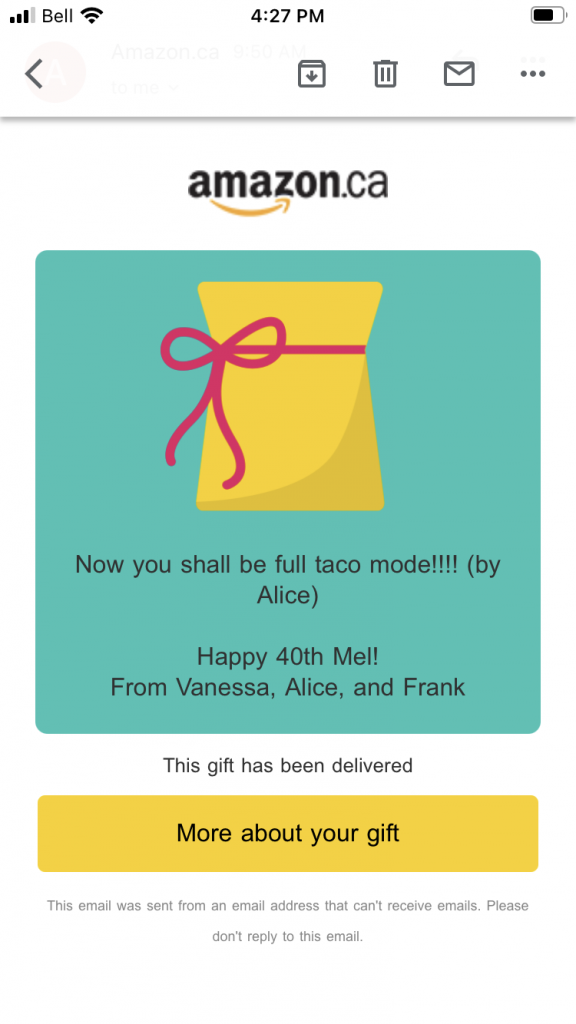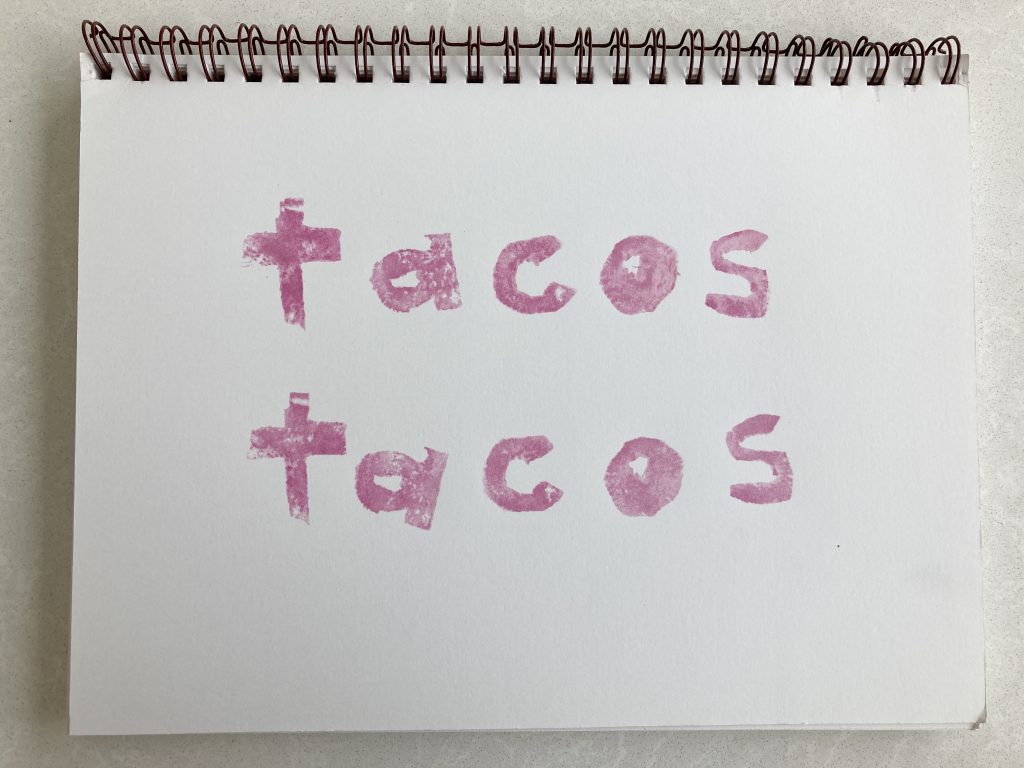Manual scripts and potato beet printing
I chose the crafty route for this task, and while we didn’t have potatoes at home, I bought a 5 lb. bag of beets last week and had already boiled and peeled a few that had been waiting patiently in the fridge for someone to eat them. Honestly, I couldn’t think of better use for these beets and transformed them into letters; they are self-inking vegetables, after all.
I printed the word tacos, because it’s my favourite food, and Taco is my nickname. I celebrated my birthday earlier this week, and my family sent me one of those round taco/burrito flour tortilla blankets, with the following note written by my niece.

With that introduction, I go full taco(s) mode and present to you a brief 43 second timelapse video of the manual script beet printing process.
The delightful chore of manual beet printing
It didn’t take me long to create the letters, however I do realize cutting cooked, sliced beets is much easier than carving raw potatoes and so creating manual letters with this alternate vegetable was a bit of a shortcut. It took me much longer to piece together a filming setup to hold my iPhone above the cutting board and paper so I could create a timelapse bird’s eye view of the process (details in footnotes).

The curved-tip knife I used wasn’t as easy to maneuver, especially in cutting circular lines in the a, c, o, and s, but I did my best without obsessing over obtaining perfection with each letter. After all, I had more cooked beets to work with. Any error wouldn’t have taken much time or additional resources to recreate. Straight lines were easier to cut, but even my letter t wasn’t proportionally perfect, with a thicker cross stroke than the downward stroke. The letter o had some little devil horns I failed to cut away, so I just made sure to use the other side of the o when printing. I imagine carving these letters in a potato would have been much more labour intensive and any errors would have been difficult to remedy and used up more resources.
I managed to print every letter clearly on the page without smearing anything, but I didn’t drop the letter a exactly where I wished. Still, I don’t think the prints look half bad. This was a fun diversion, but would I want to create letters and print a whole text this way ? Absolutely not.
The manual printing process made me thankful that we are no longer reliant on handwriting or letterpress printing or even manual typewriters to produce quality works of writing. I felt for the monk in Harris’s (2018) podcast on the history of the printed book and how soul-crushing his job must have been when I heard the following, which he had written in the margins of the book he was hand scripting:
Writing is excessive drudgery. It crooks your back, twists your stomach and your sides. The book which you now see, was written while I froze, and what I could not write by the beams of the sun I finished by candlelight.
The monk’s experience and job copying books was not a willing task he performed, it was his duty. What did he gain from his careful, diligent hand scripting? What undue stress fell upon him for the monumental task for which he was designated? Did he recognize his unique contribution to knowledge? When we write today do we recognize ours?
Info about Film setup: I used a 2.5 foot tall drink table, a drafting tool called a t-square that looks like a ruler with a T, and a 7 lb handweight to hold the t-square down. The t-square has a round hole in it, and though I don’t know what its true purpose is, it was perfect for aligning my iPhone’s camera above the cutting board to take a timelapse video.
6 replies on “Task 4”
Hi Mel! Happy Birthday! I love how you chose the word that tells a story about you. Really, in the fully online program, there are now so many opportunities to get to know each other.
Beet printing is such a cool alternative to potato printing! And your printing tool had natural color ready for you to use – just brilliant! Wondering how different the second the print would look if you did try to apply some color on the stamps.
Thank you, Olga!!! It’s funny – this one beet was the only one in the bunch I had cooked that got eaten. I wish I had used the letters to make more words and attempted different inks, as well as surface – the snow would have made an interesting canvas!
Hi Mel! Happy Birthday! I love how you chose the word that tells a story about you. Really, in the fully online program, there are now so many opportunities to get to know each other.
Beet printing is such a cool alternative to potato printing! And your printing tool had natural color ready for you to use – just brilliant! Wondering how different the second the print would look if you did try to apply some color on the stamps. I think you could get some pretty interesting results there.
Thank you, Olga! I thought about other inks and to try it in the snow – next time around!
Cute nickname! I noticed that you made individual letter stamps, which makes a lot of sense, you could write cat or tao or sat or coat, so many options! I wrote my word (QUARK) on a single potato so that it was the only thing my potato stamp was capable of writing. I love the idea of having a self inking vegetable, I used stamp ink and it was difficult to get it on the potato because it was wet itself. I think you have shown exceptional artistic ability sculpting your letters, and thank you for showing us your methods! Happy belated.
Thank you, Olivia! I am intrigued why you chose the word quark, so I’m going to your blog now!